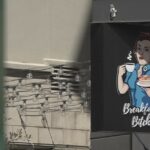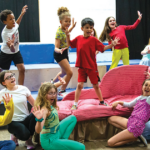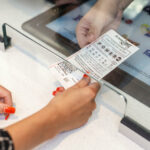Barbie is not just a doll that has been played with by children of various generations. She is also a fashionista who has followed trends since her inception.
“Barbie: A Cultural Icon,” a traveling exhibit that looks at Barbie’s over 60-year brand history and the doll’s influence on pop culture, will visit the Phoenix Art Museum through Sunday, July 7.
Along with the Barbie exhibit, the museum will also have a complementary exhibit called “The Power of Pink.” It draws from the museum’s collection and delves into the history, science and societal connections associated with pink, a color synonymous with Barbie.
The Barbie exhibit was created by Illusion Projects and was curated by costume historian Karan Feder, who collaborated with Mattel Inc. The Phoenix exhibit was coordinated by the Phoenix Art Museum’s Jacquie Dorrance Curator of Fashion Design Helen Jean. It features over 250 vintage dolls, including the original Barbie with the zebra-print bathing suit.
Feder said the display appeals to people of different ages. “Because Barbie has been around for 65 years, there are three generations that can land at this exhibit and find things that they relate to, from people my age, a grandma, to their daughters and then their daughters’ daughters,” Feder said.
The dolls and fashions on display come from the private collection of David Porcello and from Mattel. Almost all of the vintage pieces are from Porcello’s collection, which features pieces that were opened and used.
“A lot of Barbie doll collectors, they collect things that are still in the package, and they keep everything in the package,” Feder said. “David collected pieces that were played with. He thought that added value.”
The exhibit, which is broken down into six sections, includes life-size fashion designs; interviews with designers; historical accessories and outfits; and information on the fashion trends, careers and identities of Barbie over the years.
One portion of the exhibit highlights the original 22 ensemble outfits created for Barbie. “We chose to mount those original 22 outfits from 1959 not on the doll body but in shadow boxes mounted in little frames to really treat them like mini works of art,” Feder said.
“When you see them mounted like that, you really get an understanding of the detail that went into these original ensembles. There’s one ensemble called ‘Roman Holiday’ that has 16 separate pieces that make up this single ensemble, everything from a little hat, to shoes, to a little compact case, a little comb, a purse. The eyeglasses had a little separate eyeglass case.”
Other areas give focus to different aspects of the Barbie universe, including the creation of the first Black doll Christie, the influence of the Space Age, the introduction of Ken, and the development of the Barbie Dreamhouse.
Although the display is focused on Barbie, it does have Christie and Julia dolls and examples of Ken from the ’60s, ’70s and ’80s. The exhibit showcases the evolution of Barbie, with dolls highlighting her different careers, body types and ethnicities.
Attendees will have a chance to take pictures in front of several interactive photo-op areas, including a life-size Barbie Mirror-Pink Corvette. “That’s a car that you can actually sit in,” Feder said. “It’s a great Instagrammable moment. There are some other moments like that where you can sit in a Dreamhouse and take a picture. There are really fun life-sized recreations of Barbie television sets that she had for her Dreamhouse, and the television sets work and play vintage Barbie television advertisements.”
One section provides a glimpse of what Barbie looks like before she is painted, what different hair types are available for the doll, and what the hair is made with, as well as how a designer’s workstation would look.
In the exhibit “Barbie: A Cultural Icon,” life-size designs and Barbie fashions are juxtaposed.
Feder started working on the Barbie exhibit during the height of COVID-19. She was inspired by her colleague Porcello’s collection of Barbie fashions. “David Porcello has been collecting vintage fashion for his entire life. When he was 8, he remembers for his birthday asking his mother for something from vintage fashion whether than a toy. … I knew that his vintage fashion collection also included vintage Barbie fashion. … It was never his intention to collect the dolls. The dolls were less of interest to him than the actual miniature fashions. So, his collection was entirely focused on Barbie’s wardrobe,” Feder said.
Feder said within the exhibit, she wanted to explore how Barbie’s fashions ran parallel with societal fashion trends. “We wanted to see if we could prove that in fact, Barbie fashion did reflect the fashion of the moment in the culture,” Feder said. “So, we thought the best way to do that would be to bring out life-sized fashion that we could juxtapose with Barbie fashion, life-sized fashion from the runway, in Vogue Magazine or on entertainers. Was there something we could point to, and in eight months, we would see a Barbie fashion that’s released?”
Feder also hoped the exhibition would bring awareness about the designers working behind the scenes on Barbie fashions. Feder said it could be a challenge to make a Barbie outfit that looked similar to something featured on a runway or in a fashion magazine.
“It’s not as simple as it sounds to take a silhouette that is super popular at the moment and translate it to Barbie size, which isn’t necessarily human size,” Feder said. “There’s a lot of math involved there. And there’s also, in terms of pattern-making, a lot of problems with creating a pattern that is based on a life-sized silhouette for a one-sixth-sized Barbie. The main problem is you’re using a fabric that is the weight for a human being. It’s super thick. It’s six times thicker than a Barbie fabric would be. That’s one of the reasons why — and this is something I never thought of until I started diving into the rabbit hole of this project — the Barbie waist is so small.
“It’s less of an aesthetic to be pleasing when she doesn’t have clothes on but to be pleasing when she does have clothes on. Pleating and gathering adds such width to a garment that in order for the waistline to look correct once she is dressed with all of those layers and layers of fabric at the waist, the doll actually needed to be much thinner in the waist.”
In doing research for the exhibit, Feder looked into designers such as Carol Spencer. “She is really fascinating because she stayed with the company for 35 years. … She has documented in a book called ‘Dressing Barbie’ her time there and her favorite pieces. She remembers some of her inspiration for these outfits, which is really quite rare because there isn’t really a Mattel archive that documents the work of its designers, at least from that period of time,” Feder said.
“In modern times, Mattel has been very good about giving credit to individual designers, but up until the mid-’80s, that wasn’t something that wasn’t done by Mattel. A lot of the early pieces we don’t know but because of Carol’s book, she did point out the pieces that she designed. So, when we’re able to credit folks, we do, and you’ll see in the object labels that we credit these designers when we can.”
Feder said the way Barbie fashions are designed has changed since the early days. “Nowadays, the fashion designers at Mattel have their own specialty silos, and they have lots of other artisans to support their work,” Feder said. “They reach out to the people who are experts at molding plastic for shoes or experts that are molding accessories. The earlier designers did all of that work. They did all of the accessories. They did everything themselves.”
Source link
By Laura Latzko, GSN Staff Writer , www.gilbertsunnews.com
www.gilbertsunnews.com – Vivrr Local Results in community of type article , 2024-03-20 07:00:00
Categories:
Tags: barbie: a cultural icon, barbie, illusion projects, the power of pink, phoenix art museum
















































































































































